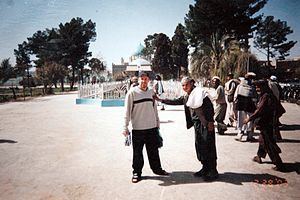Location Kandahar, Afghanistan Architectural style Islamic architecture | Architectural type Mosque Affiliation Islam | |
 | ||
Similar Lashkargah Mosque, Khost Mosque, Pul‑e Khishti Mosque, Great Mosque of Asmara, Abdul Rahman Mosque | ||
The Shrine of the Cloak (Pashto: Kerqa Sharif) is located adjacent to the main mosque in Kandahar, Afghanistan. It contains the Kerqa, a cloak believed to have been worn by the Islamic prophet Muhammad. It is therefore widely held to be one of the holiest Islamic sites in Afghanistan, and even considered by some as the "heart of Afghanistan".
The building's exteriors are of green marble from Lashkar Gah, with tiled surfaces and gilded archways. The cloak itself is locked away inside the mosque and is rarely seen. It has been guarded by the same family for over 250 years. Its guardians have traditionally only shown the cloak to recognized leaders of Afghanistan, although in times of great crisis such as natural disasters, it has been publicly displayed as a means of reassurance.
The cloak was given to Amir Ahmad Shah Durrani by Amir Murad Beg of Bukhara in 1768 in order to solidify a treaty between the two leaders. An alternate account states that when Ahmad Shah had traveled to Bukhara, he saw the cloak of Muhammad. He then decided to take the artifact with him to Kandahar, and asked whether he could "borrow" the cloak from its keepers. They, worrying that he might try to remove it from Bukhara, told him it could not be taken from the city. Ahmad Shah then is said to have pointed to a heavy stela of stone firmly planted in the ground, saying that he would never take the cloak far from the stone. The keepers, gratified at his answer, handed him the cloak. Ahmad Shah then took the cloak, ordered the stone slab to be dug up, and carried them both back with him to Kandahar, where the stone now stands near his mazar (tomb).
The cloak was last seen in public in 1996, when Mullah Omar, the up-and-coming leader of the Taliban, removed it from the shrine and donned the cloak while he stood atop a building, and in front of a large crowd of his followers. That symbolic act is commonly considered a key point in the rise of the Taliban, and Mullah Omar himself, associating him with both Ahmed Shah Durrani and the Prophet of Islam. Upon donning the cloak, the crowd began to shout "Amir al-Mu'minin" (Commander of the Faithful), a title that Ayman al-Zawahiri still occasionally uses to refer to Mullah Omar in his radio addresses. Wahid Muzhda, an Afghan analyst and one-time high-ranking official in the Taliban foreign ministry, disputes Mullah Omar donning the cloak. "From what I know, from sources close to Omar, and from a chat with the keeper of the shrine [where the cloak is kept], Omar did not wear the cloak." Wahid Muzhda's doubts notwithstanding, in a New York Times piece from winter 2001, the current keeper of the Shrine, Qari Shawali, claimed that he not only allowed Mullah Omar to view the cloak, but that it was borrowed and removed from the Shrine in the spring of 1996 by Mullah Omar. This was the third time in his lifetime that a man attempted to look at, let alone don, the cloak.
